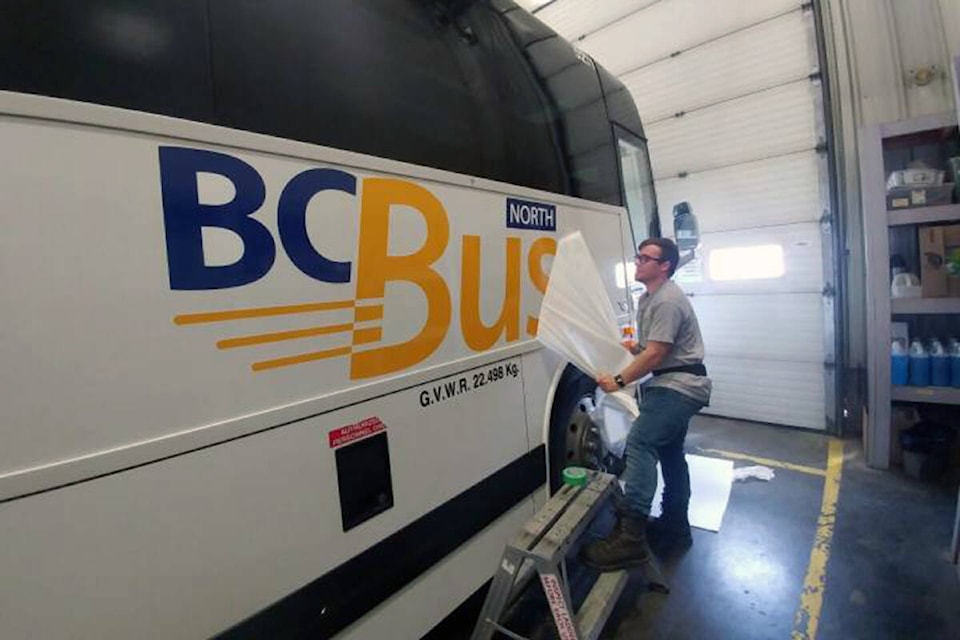The local cost of running the provincial bus service in this area has gone up since it started six years ago.
After some COVID-era grants were provided by the B.C. government to keep the local taxpayers’ costs down during the pandemic, the time has come to invest more out of municipal pockets.
The provincial government paid about $515,000 of last year’s bill to run a bus from Burns Lake to Prince George and from Burns Lake to Smithers. Local governments combined, through the Regional District of Bulkley-Nechako (RDBN), paid approximately $140,000. Tickets from the riders amounted to around $26,000 at $5 per ride.
The system is centred in Burns Lake, with a route back and forth to Smithers and a route back and forth to Prince George. The Burns Lake-Prince George leg had 4,318 riders last year, and the Burns Lake-Smithers route had 2,078 riders.
RDBN staff has proposed an increase in the overall Regional District budget to $200,000 which would cover the increasing costs of fuel, drivers, servicing, etc. plus have a robust contingency built in for anything unforeseen.
When asked at the RDBN board table about the state of the uptick in costs, chief financial officer John Illes said “No major changes, just inflationary pressures.” He explained that the proposed $200,000 would not necessarily, or even likely, be all spent, just be at the ready, enabled by bylaw.
The annual operating agreement with BC Transit was passed without discussion by the RDBN board of directors, but the proposed new fee structures had a great deal of discussion.
It was noted by RDBN director of planning Jason Llewellyn that no rural areas currently pay into the system, but the data shows it should be looked at. The reason for that was the indirect benefits to the region, even if the bus doesn’t pull right up to the curb in any of the rural communities. For example, the municipality of Fort Saint James does already pay into the system at a smaller rate than the Highway 16 communities, despite there being quite a distance from that town to the bus route. Llewellyn pointed out that research on passengers showed “a lot of those riders (between Vanderhoof and Prince George) are from Fort St. James, and if they were left stranded, that would make for a significant safety issue.”
Some of the discussion at the RDBN board table wondered about raising the fees, so the rider themselves paid more of the overall bill. Burns Lake mayor Henry Wiebe noted the $5 cost “is basically free” and he described his initial skepticism about the service when at first he saw very few riders getting on and off, but then learned of full busloads as well.
No decision was made on the point of upping the rates, although it was clear from the data that little of the budget would be affected at any reasonable price, and the whole point of the service, it was pointed out, was to provide safe transportation for those who could least afford it.
Some directors brought minds back around to the original purpose of the service: primarily vulnerable females.
Smithers mayor Gladys Attril said, “I just invite people to think back to what that was like,” when there was little or no bus service. “There is another cost to us all.”
What does any electoral area pay for a wide-ranging search for a missing girl? A murdered one? What’s the cost to an electoral area when that girl is your resident? Or the perpetrator?
“I have seen a real decrease in the amount of hitchhikers, and I don’t think I need to remind anyone that we have that title of the Highway Of Tears which always really bothers me,” said Houston mayor Shane Brienen.
He also pointed out another backbone reason his community needs the bus service. His is “the largest community in the province without a hospital,” Brienen said, and many of the bus service’s riders are Houston residents heading to medical appointments in towns with better medical service, or other social services.
The directors voted in favour of RDBN staff working on options that would provide better cost and service certainty with $200,000 being the outer limit, and to explore fee structures for riders.
At the suggestion of Francois-Ootsa Rural director Clint Lambert, the RDBN will also look to lobby higher government for the removal of the carbon tax on mass transit, as another way to reduce operational costs. Every rider on that bus, he said, represented hours and hours of vehicle emissions subtracted from the atmosphere, so their mode of group travel should not be subjected to the tax aimed at reducing emissions.
